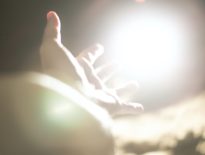Religious people believe in the positive results of their faith in God. There is a common expectation that faithful people will lead good, healthy lives, while bad people will experience trouble, illness and punishments. The reality, however, is much more complex and often contradicts such expectations. How useful is religious faith when it comes to health, or the healing of the sick?
When we talk about religion we refer to a set of beliefs, rituals and practices identified in a community of believers. In general, religion is considered as implying adherence to the beliefs and practices of a religious institution, while spirituality is understood as a personal, subjective experience. Therefore, even when we use the term ‘believers’ to identify members of a religious organisation, we must not overlook the personal aspect of the spiritual experience which, most of the time, has a bigger influence on the life of an individual than his or her affiliation to a certain religious community.
Religion favours health
Various studies confirm that faithful people have a higher resistance to illnesses. A paper published in 2003 reviews[1] the results of multiple studies on the relationship between religiosity and physical health. As expected, religion/spirituality had a significant impact on health. Subjects which were actively involved in the life of the church turned out to have higher longevity and an increased recovery capacity in case of illness. Researchers claim that there is nothing miraculous in this. The person’s psychoactive state of well-being, derived from religious belief would be responsible for the above mentioned effect. Getting involved in church activities (attending religious services, volunteering for helping others) provides believers with a feeling of personal worth, which is essential for a good health.
We must also remember that religious affiliation, in itself, directly determines the lifestyle and, implicitly, the overall health of the individual. Some religious groups prohibit the consumption of alcohol, tobacco or drugs. Many other religious organisations discourage the consumption of harmful substances or foods. Seeing that many physical ailments are generated by the consumption of alcohol, tobacco or drugs, it is easy to see why the number of these health issues is lower within faith communities.
One of the most representative studies in this area is the case of Seventh-day Adventists, who share the general Christian values, but distinguish themselves through the focus they place on health, derived from a theocentric approach to lifestyle. Studies have shown that the general health status of Adventists is usually above average, as is their longevity. This is explained by the lifestyle the members of this religious community generally adopt. Adventists are known for strict abstinence from smoking, alcohol or other drugs, from excluding pork meat from their diet, and for promoting a vegetarian diet.
In the last 40 years, over 300 medical scientific articles have been published on the Adventists’ health and lifestyle. The first large-scale research, the Adventist Mortality Study, studied 23,000 Adventists from California. It was carried out between 1958-1965 to 1985, and was financed by the American government. Another major study, financed by the National Cancer Institute in the USA., began in 1974 and lasted until 1988. All the studies confirmed a lower incidence of cardiovascular disease and cancer, but also a higher life expectancy for Adventists than for the rest of the population. Studies have shown that the life expectancy was 7.28 years higher for men and 4.42 years higher for women. Vegetarian Adventists stood out with an even higher longevity than the Adventists with an omnivorous diet. Thus, in vegetarian Adventist men there was an increase of 9.5 years, and in women an increase of 6.1 years.
There is no doubt that religion has a positive influence on a person’s well-being. Faith stimulates optimism, and worship offers the opportunity to experience feelings which are beneficial for one’s health. Affiliation to a religious group provides an incentive to censor deviant behaviour, creating the opportunity to establish healthy social relationships, with positive effects in general, but especially in periods of trauma or post-trauma.
The healing power of faith
Scientists and theologians alike agree on the fact that the universe functions according to consistent and dependable laws. From a theological perspective, ignoring the natural laws is similar to ignoring the divine laws. From this point of view, the preoccupation with preserving one’s health is sacred to at least the same extent that prayer for the healing of a sick person is. History has also recorded occasions in which God offered the miraculous gift of healing. Faith healing is a concept according to which illness can be defeated by faith in God. Invoking the divine power is done by prayer or other rituals. Such practices are common to all religions around the globe, and, undoubtedly, there are cases of healing through religious rituals without them being limited to a particular denomination.
Dr. Alexis Carrel (1873-1944), French surgeon and biologist, winner of the Nobel Prize for Physiology and Medicine (1912), is known for his opinion regarding the power of prayer. In 1941, he published an article about prayer in the Reader’s Digest. Carrel would come back to this subject, in an essay titled “Prayer”: “Among the innumerable effects (of prayer), the physician especially has the opportunity to observe those which we call ‘psycho-physiological and curative effects’,” wrote Carrel.
But can prayer be used as a healing and treatment tool? Louis Rose, a British psychiatrist, investigated hundreds of what we call “miraculous healing cases”. In his book, Faith Healing, published in 1971, he reached the following conclusion: “I was unsuccessful. After almost 20 years of work I have not yet found a ‘miraculous healing’ and without it I cannot be convinced of the effectiveness of what, in common parlance, is called ‘faith healing’.” The problem grows even deeper if we think that, in the last three decades, more than 200 children died in the US[2] due to treatable illnesses, because their parents relied purely on the healing power of faith and refused conventional treatments.
On the other hand, cardiologist Randolph C. Byrd[3] authored perhaps the most famous study supporting the usefulness of intercessory prayer for the sick ever published in a specialised magazine (1988). The double-blind[4] study proved that patients who had been prayed for felt much better than the rest. The validity of the study was frequently attacked. Numerous critiques have been brought including to the medical journal which published the study. Over the years, various experiments have either confirmed[5] or refuted[6] the healing power of prayer.
The bad news for researchers is that miraculous healing is a phenomenon which does not operate according to a mathematical model—otherwise it could not be called a miracle. Impossible to reproduce on demand, in a laboratory, faith healing cannot be made the object of scientific research. On the other hand, how could one use research tools to analyse a spiritual phenomenon? In the given situation, it would be like trying to check the grammar of a text using a caliper. Is it possible that the researchers’ materialistic approach truncates the complexity of the healing process, imposing a limited definition of what we call miraculous healing?
In all cases of faith healing, the common element is trust in a much brighter future, in the capacity to defeat illness with help from above. Religious people cannot say how miraculous healing happens (nor are they preoccupied with such things). This is left to the Almighty. They just attribute the intervention to divine healing—God having the liberty to use any kind of method to reach the final goal.
On the other hand, researchers say that faith healing cases are similar to the phenomenon called “the placebo effect” which, in essence, is nothing supernatural. The sick person’s expectation that the medicine or procedure will bring relief or healing bears fruit. Conversely, when a substance or a neutral procedure leads to negative effects, according to the patient’s expectations, the reverse phenomenon, called “the nocebo effect” occurs. It may well be that a phenomenon similar to the placebo effect occurs when a person strongly believes that a prayer or a ritual will help them heal. However, this does not cancel the “power of faith”, but comes as a confirmation. In the context of the believer’s experience, faith is the conviction that God is the One who heals, an aspect which cannot be at all denied, nor refuted by experiments.
Unfortunately, the phenomenon of faith healing is paradoxically overshadowed by the very people practicing it. Many of the so-called miraculous healing incidents are shams and frauds. The American Kathryn Johanna Kuhlman (1907-1976) was a healer and gospel preacher, who in the ’60s-’70s promoted her healings on the television show “I Believe in Miracles.” According to research conducted by Dr. William A. Nolan, none of the many cases in which Kuhlman claimed that healing happened could be confirmed. The case of a lady who was said to have been healed from spinal cancer is infamous. When brought on stage, the woman began walking, “by faith”, and the audience was very impressed. What people did not know is that, the second day, the woman’s spine gave in and four months later she would pass away.
Many of the healers calling themselves “Heaven’s messengers” do not demonstrate God’s power, but rather the power of deception. Their interest is not directed towards the well-being of the suffering person, but to fame, spectacle and wealth. Sick people who turn to such healers should learn to identify this detail and not let themselves be fooled by them.
World of miracles
Louis Rose declared that his studies had not helped him to identify any miraculous healings. But what is a miracle after all? We often think that phenomena which can be explained by natural laws are natural phenomena, and those that cannot be thus explained are miracles. Such an approach, a legacy of the illuminist mindset, is deficient because the miracle will be perceived depending on the degree of information rather than on the nature of the phenomenon itself. In other words, understanding the phenomenon’s processes will result in the destruction of the miraculous aura because the starting point is a materialistic perspective.
The materialistic approach destroys life’s mystery by its rigid reductionism, limiting processes to mere reactions, feelings to mere neural impulses, and health to the “good functioning” of systems and organs. Focusing on the constituent elements of a system, materialism reaches a point where it can’t see the wood for the trees, mistaking the cause for the purpose.
It is, however, possible to take a convergent approach. The phenomenon of falling in love can serve as an example for this purpose. Falling in love can also be “explained” from a biochemical perspective, without having to ignore love’s thrill, not even from the perspective of the world’s greatest biochemist. Following the same trail of thought, according to his theory, Freud did not believe in love because, to him everything was but a manifestation of sexual impulses. For the Austrian neuropsychiatrist, the end of all things was sexuality. Nevertheless, he himself implicitly admitted that love cannot be reduced to the mere level of sexual impulses. This is exactly why he wrote to his fiancée: “When you come to me, little Princess, love me irrationally!”
Mechanistic materialism becomes ridiculous in its attempt to explain all phenomena by analogy with mechanical ones. The materialistic approach is sequential and, therefore, limited, offering a partial and, at times, distorted understanding of reality. Experiments and tests associated with the materialistic paradigm will not be able to unravel the mysteries of miracles, not even those in the medical field.
Certainly, matter is easy to research with scientific tools, but is it not science that draws our attention to the fact that existence is much more complex and must not be limited to the material aspect? In the same way that Einstein’s theory of relativity does not cancel the laws of Newtonian physics, so an approach to the world from a spiritual (religious) perspective is not antagonistic to the material perspective, but rather complementary. For instance, a socio-phobic teenager, with low self-esteem, comes in contact with a religious community. For a psycho-sociologist, the teenager’s further development will be explained in terms of strengthening his self-image and feelings of personal worth, as well as the result of healthy interactions with the social group of believers. For the members of the church in whose religious life the teenager participates, his transformation is a miracle, clear evidence of a life changed by divine power.
Thus, the miracle has nothing to do with magic and ignorance and everything to do with the recognition of divine power. The miracle is, therefore, not something there is an explanation for, but, on the contrary, something that, by the very understanding of the complexity of the process, through an act of faith, will be attributed to God. With such an approach, the rush for miraculous healing would soon come to a standstill. But, “We live in a world of instant solutions…When we have a problem, we expect God to just hand down our prescribed answer easily, immediately, just the way we ordered it.”[7] In the light of sacred history, one can say that God does not perform such miracles. This explains why unrealistic expectations regarding miracles become the source of much frustration and dissatisfaction.
God does not seek to protect believers in a miraculous way, by means of an invisible shield or by offering them, time and time again, quick fixes to all illnesses. He protects them, first and foremost, through commandments and counsel that keep them from harm. And, if the internal mechanism of a miracle starts being deciphered, that does not make it any less miraculous, in the same way that advanced electronic technology used for a vehicle doesn’t stop working just because the wheel is taken by an engineer specialised in electronics. In His time, God intervenes in a man’s life, but according to His sovereignty. For instance, the apostle Paul healed a cripple, but the Bible does not tell us he would have performed the same miracle for his companions suffering from the same condition. Also, a miracle is not a magic show; Jesus did not perform miracles just because Herod wanted to be entertained. In this context, one may say that many of the modern opportunities for public healing have nothing in common with the attributes of a veritable miracle, ignored by both the scientific community and the religious.
For a deeper understanding of health and the (miraculous) healing process, materialistic researchers are challenged towards a holistic approach[8] to the human being. In their turn, religious people should dispense with superstition and obscurantism and rediscover the power of faith in a God who, in His wisdom, offers principles for a healthy lifestyle, and who, through His power, offers healing by more or less comprehensible methods.















